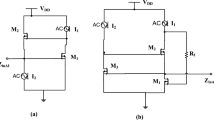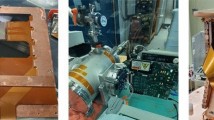Abstract
The crosstalk between CMOS pixel sensors (CPS) degrades the performances of detector systems. Moreover, power distribution becomes a challenge in the future detectors for high energy physics experiments. In order to address these problems, a power management is proposed. Power supply voltages and reference voltages are internally generated in CPS. Two full on-chip linear regulators are proposed in this paper. Low area, low power consumption and low noise are achieved by a novel structure. The regulators have been designed and fabricated in a 0.35-μm commercial process. The measurement results are also presented.









Similar content being viewed by others
References
Hu-Guo, Ch., Baudot, J., & Bertolone, G., et al. (2009). CMOS pixel sensor development: A fast read-out architecture with integrated zero suppression. Journal of Instrumentation 4(04), P04012
Winter, M. (2010). Achievements and perspectives of CMOS pixel sensors for charged particle tracking. Nuclear Instruments and Methods in Physics Research Section A, 623(1), 192–194 doi:10.1016/j.nima.2010.02.192.
Chasman, C., Beavis, D., Debbe, R., Lee, J. H., Levine, M. J., Videbaek, F., & Xu, Z. (2008). A heavy flavor tracker for STAR. Berkeley: Lawrence Berkeley National Laboratory. http://escholarship.org/uc/item/0cn2q79k Accessed 5 Aug 2008.
Degerli, Y. (2009). Design of fundamental building blocks for fast binary readout CMOS sensors used in high-energy physics experiments. Nuclear Instruments and Methods in Physics Research Section A, 602(2), 461–466
Wang, J., Gao, D., Valin, I., Dorokhov, A., Hu, Y. (2011). A full on-chip, low noise, low power consumption reference generator in monolithic active pixel sensors. Nuclear Instruments and Methods in Physics Research Section A, 659(1), 98–105. doi:10.1016/j.nima.2011.08.026
Weber, M. (2008). Power distribution for SLHC trackers: Challenges and solutions. Nuclear Instruments and Methods in Physics Research Section A, 592(1–2), 44–55. doi:10.1016/j.nima.2008.03.107
Faccio, F., Michelis, S., Orlandi, S., Blanchot, G., Fuentes, C., Saggini, S., & Ongaro, F. (2010). Development of custom radiation-tolerant DCDC converter ASICs. Journal of Instrumentation, 5(11). C11016
Weber, M., Villani, G., Tyndel, M., Apsimon, R. (2007). Serial powering of silicon strip detectors at SLHC. Nuclear Instruments and Methods in Physics Research Section A, 579(2), 844–847 doi:10.1016/j.nima.2007.05.290
Wang, J., Gao, D., Zheng, R., HuGuo, C., & Hu, Y. (2011). A 200 mA low-area, low-noise, low-dropout linear regulator for monolithic active pixel sensors. 6th IEEE Conference on Industrial Electronics and Applications (ICIEA), 2011, Beijing, China (pp. 2693–2697). doi:10.1109/ICIEA.2011.5976052.
Chava, C.K., Silva-Martinez, J. (2004). A frequency compensation scheme for LDO voltage regulators. IEEE Transactions on Circuits and Systems I: Regular Papers, 51(6), 1041–1050 doi:10.1109/TCSI.2004.829239
Giustolisi, G., Palumbo, G., & Spitale, E. (2007). LDO compensation strategy based on current buffer/amplifiers. 18th European Conference on Circuit Theory and Design, 2007. ECCTD 2007, Seville, Spain (pp. 116–119). doi:10.1109/ECCTD.2007.4529550.
Tsz-Fai, K., & Wing-Hung, K. (2007). A stable compensation scheme for low dropout regulator in the absence of ESR. Proceedings of the 33rd European Solid-State Circuits Conference, 2007 (ESSCIRC 2007) , Munich, Germany (pp. 416–419). doi:10.1109/ESSCIRC.2007.4430331.
Acknowledgments
The authors would like to thank H. Pham and M. Jankowskj for the fruitful discussions, F. Morel and G. Bertolone for their help of chip fabrication and M. Goffe for his help of measuring chip. This work is partly supported by China Scholarship Council (CSC).
Author information
Authors and Affiliations
Corresponding author
Rights and permissions
About this article
Cite this article
Wang, J., Gao, D., Hu-Guo, C. et al. A low-noise and low-area-consumption power management dedicated to CMOS pixel sensors for high energy physics experiments. Analog Integr Circ Sig Process 75, 359–367 (2013). https://doi.org/10.1007/s10470-013-0057-3
Received:
Revised:
Accepted:
Published:
Issue Date:
DOI: https://doi.org/10.1007/s10470-013-0057-3




